We English is now officially out, available online and in all good bookshops! Here are some initial reviews-
NEW YORK MAGAZINE, October 5 2009
Simon Roberts — Editor’s Pick
“A gorgeous series of lyrical, light-strewn photographs that the artist took of the English at play—bathers in a chilly-looking Gloucestershire, a couple miniaturized amid misty hills in East Sussex—on a tour of his homeland”
————-
THE NEW MAGAZINE, The Independent on Sunday, October 4 2009
Arts&Books Reviews, We English
“Combining a Martin Parr-esque British wit with wide, open skies and an almost visible damp chill that are reminiscent of Mike McCartney’s Liverpool photographs, ‘We English’ is the result of a year-long odyssey through England in, fittingly, a motor home. Picturing ordinary people doing curious things, Roberts looks for ‘beauty in the mundance’.â€
————-
THE INDEPENDENT, October 1 2009
This is England — Hannah Duguid
“The first place he photographed was the beach at Skegness in Lincolnshire, where people have holidayed since the nineteenth century. It’s a bit grim. The sky is overcast and the water brown, there is litter and everyone is bundled up, wearing coats. The scene is mundane and familiar to many, but Roberts has managed to bring a lyrical quality to it. The sea and sky are huge, the view is elevated and looking down we get a vast sense of space….There are two stories in his photographs: one is everyday, the other is eternal.†— Hannah Duguid
————-
BBC NEWS, October 1, 2009
The English at Leisure — Phil Coomes
“A project of this size can often take an unexpected turn and the final edit is sometimes the most challenging part. It’s tough to step back from the creation of the photographs, allowing yourself to see the pictures in the way a viewer will, and not as you remember them…. From my point of view, then, I think Simon has achieved all he set out to, and much more. The pictures are in themselves undeniably beautiful, but their real power comes from the collection as a whole. To remove from the stream of time a series of moments that are instantly recognisable as being part of life in England is a real achievement, and one that will ensure this collection will become the defining study of life in England at the end of this decade.”—Phil Coomes
————-
CREATIVE REVIEW, October 2009
‘Landscape as portrait’ – In his book, We English, photographer Simon Roberts looks at contemporary English leisure in all its collective glory
“….While many of Roberts’ images adhere to our traditional notions of beauty spots, others are of noisy, packed events like Derby Day. In each, however, the framing is such that the subjects are fixed firmly within their environment. Individuals are rendered small but, significantly, we can still read them by their expressions, their clothes and what they’re doing. It’s a technique that links back to landscape painting and the layered canvases of the 16th century. As a contemporary record, however, Roberts has captured a nation beautifully and brilliantly.”
————-
FLAK PHOTO, October, 2009
Simon Roberts: We English
A selection of photographs from We English series are featured in the October WEEKEND series at Flak Photo, an online forum for international contemporary photography, edited by Andy Adams.
————-
PHOTO DISTRICT NEWS, September 25, 2009
Simon Roberts: We English (photo of the day)
————-
DESIGN WEEK, September 17, 2009
We Happy Few, Review of Martin Parr’s Parrworld
“One of the younger photographers included in Parrworld is Brighton-based Simon Roberts, who has just completed a large project entitled We English that will be the subject of a major exhibition at the National Media Museum in Bradford next year…Like Parr, Roberts wants to swim against the tide of so much modern photography….We English looks at the country with a lyrical pastoral gaze rather than irony or sarcasm…Roberts shows people engaged in group leisure activities presented small in the frame and with light that is unfashionably undramatic. It’s a body of work that is unfashionable not only stylistically and in subject matter too. To take the photographs, Roberts covered his head with a dark cloth to peer through the concertina of a large-format view camera, essentially unchanged since the 19th century, and shot on film.â€
————-
WHAT’S THE JACKANORY, September 10, 2009
Video Interview with Andrew Hetherington on the popular What’s the Jackanory Blog.
————-
FOTO8, September 8, 2009
Interview with Guy Lane
“As pictures from his road trip around England go on display in London and New York, Simon Roberts talks to Guy Lane about people, places and his new book — We English.”
————-
LENS CULTURE, September, 2009
Simon Roberts: We English
————-
GO SEE, Issue 38, September 2009
We English – From personal identity to the beauty of banality
“Several of Simon Roberts’ shots of his country and her inhabitants, call to mind Massimo Vitali’s swarming beach images, yet Simon’s gatherings of people are different – somehow more English. The spaces come across as less tidy. Other motifs reminds us of Martin Parr’s soft touch, just more sublime and somehow more honest.â€
————-
ELUXURY, September 4, 2009
Full English Snap-fest
“In August 2007 award-winning photographer Simon Roberts embarked upon a 13-month journey around Englnd to document the lives and landscapes of his home country with a large format camera. The resulting photographs are lush in their painterly composition but defiantly mundane in subject matter, conceived as an unflinching and unbiased exploration of what it means to be English today.â€
————-
AHORN MAGAZINE, Issue 4, September 2009
Simon Roberts: We English discussed on this online magazine dedicated to contemporary photography, directed and edited by Daniel Augschoell and Anya Jasbar.
————-
THE GUARDIAN, August 22, 2009
The English at Leisure
“In search of a sense of place and belonging, Simon Roberts set off with his family to photograph England at play. The results are a beautiful, lyrical body of work.”
Posted in REVIEWS & PRESS | 1 Comment »
September 7th, 2009 admin
“Simon Roberts travelled throughout England in a motorhome between 2007 and 2008, for this portfolio of large-format tableaux photographs of the English at leisure. Photographing ordinary people engaged in a variety of pastimes, Roberts finds beauty in the mundane; the result is an elegiac exploration of identity, attachment to home and land, and the relationship between people and place. This is the most significant contribution to the photography of England in recent years.” Chris Boot, October 2009
Now that I’ve posted up the final selection of photographs from We English on the gallery page I thought it would be beneficial to publish my commentary that will feature in the back of the book. I’ve not written about every picture, rather, chosen to discuss a selection of the photographs which provide a context and reasoning behind my approach to the work. Hopefully it will prove useful and illuminating. For regular readers of the blog, some of this information will already be familiar.
I was born in Croydon, South London, in 1974. My mother is a Northerner, hailing from Cleator Moor in Cumbria, who met my London-born father when they were both working in the capital. My formative years were spent in Oxted, a provincial town in Surrey’s commuter belt, while holidays were often spent walking in the Lake District (usually in the rain) or visiting my grandparents in Angmering, a retirement town on the South Coast.
Unremarkable beginnings, you might think, and for many people, they are merely typical childhood memories. Yet they spark off a range of associations and images, of feelings and senses, which all helped begin the process of making We English.
Initially, I was simply thinking about Englishness and how my upbringing had been quintessentially English. How much of this was an intrinsic part of my identity? In what ways was my idea of what constitutes an ‘English life’ or English pastimes (if there are such things) different to those of others’? My own memories of holidays, for example, were infused with very particular landscapes; the lush green-ness around Derwent Water or the flinty grey skies – and pebbles – of Angmering’s beaches. It seemed to me that these landscapes formed an important part of my consciousness of who I am and how I ‘remember’ England.
Having returned from Russia in late 2005, where I’d spent a year travelling across the country to produce the book Motherland (Chris Boot Ltd, 2007), I was ready to develop some of the same themes that I found in Russia. Motherland was an exploration of, among other things, the Russians’ attachment to their homeland. This attachment to place was somewhat mysterious, simultaneously profound and mundane, and it led me to think about my own attachment to England. So We English also began as a development of my Russian work, springing from my fascination with peoples’ (and my own) sense of belonging, of memory, identity and place. And We English would be another journey, not quite as epic as the one across Russia, but nonetheless involving a 1993 Talbot Express Swift Capri motorhome, a two year old, a pregnant wife and my apparatus of choice: a 5×4 large-format camera.
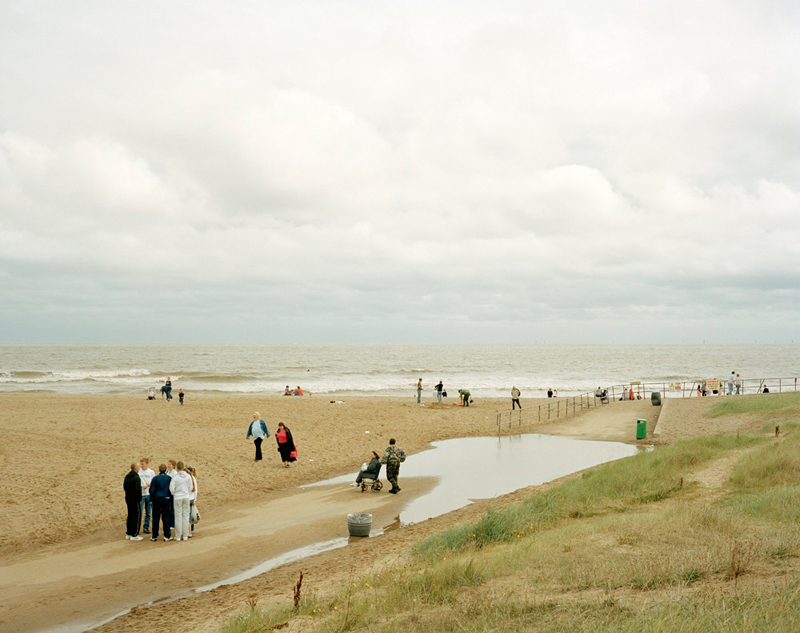 Skegness Beach, Lincolnshire, 12th August 2007
Skegness Beach, Lincolnshire, 12th August 2007
This image from Skegness was one of the first photographs I took during an initial research trip for the project in August 2007. When I saw this photograph on the contact sheet afterwards, I knew I’d begun to develop a formal composition to my framing which would define the direction of the work. I would move away from photographing the individual and engage instead with the idea of the collective, of groups of people populating the landscape. Photographing from elevated positions (often from the roof of the motorhome, as it turned out) would enable me to get a greater sense of people’s interaction with the landscape and with one another. I also decided that the figures would be relatively small in the frame, although not always so small that you couldn’t make out some facial expressions, what they were wearing and their activities. This way of seeing was influenced by looking at the work of 16th-century Dutch and Flemish landscape painters – particularly Hendrick Avercamp, Pieter Bruegel and Lucas van Valckenborch, who depicted winter scenes teeming with life. I liked the idea of what appeared to be predominantly pastoral landscapes becoming, on closer inspection, multi-layered canvases, rich in detail and meaning.
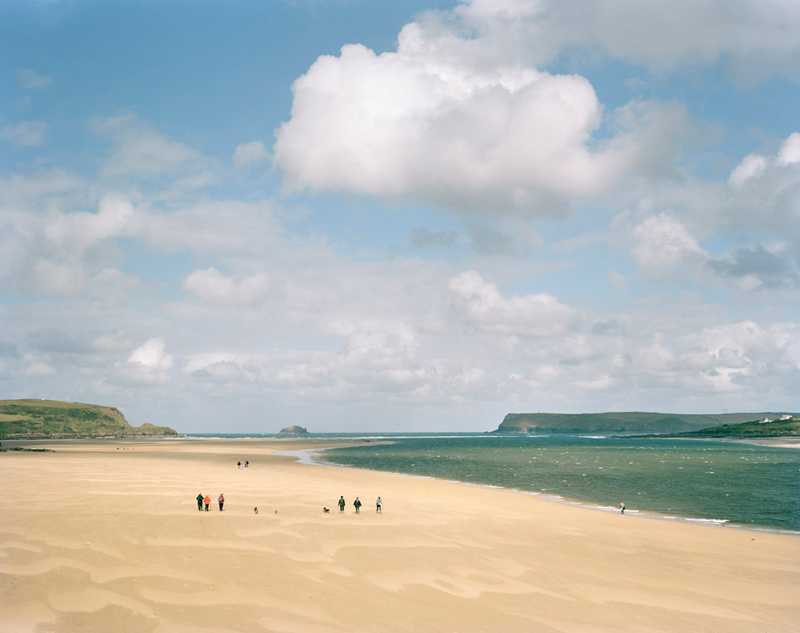
Camel Estuary, Padstow, Cornwall, 27th September 2007
I set myself a fairly rigorous framework within which to work, in terms of geographical boundaries (England, not Britain) and composition (landscapes, not portraits), and I fixed on leisure as a thematic starting point. Looking at leisure activities struck me as a thought-provoking way of exploring England’s shifting cultural and national identity. They seem to say much more about who we are than, for instance, what we do in the workplace. Leisure activities can be aspirational, revealing as much about how we see ourselves as how we wish others to see us. And landscape is an intrinsic part of these leisure experiences. It is a commodity: we consume it and utilise it and make it ours, even though we rarely own it.
So I decided to produce a series of detailed colour landscape photographs – tableaux – which would record places where groups of people congregate for a common purpose and shared experience.
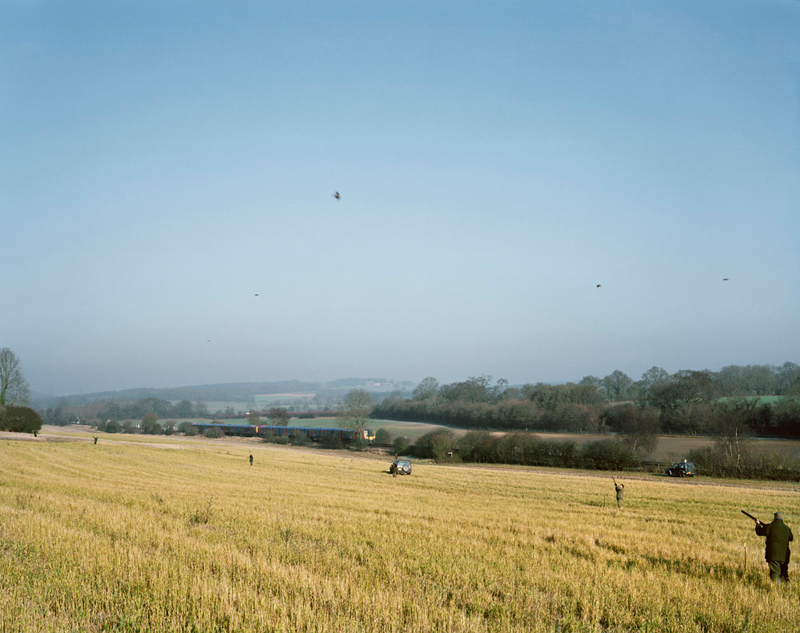 Heberdens Farm, Finchdean, Hampshire, 20th December 2007
Heberdens Farm, Finchdean, Hampshire, 20th December 2007
It is worth noting, of course, that one person’s leisure often involves another person’s work. This is particularly true of a pheasant shoot, where there are as many people working – gamekeepers, dog handlers, and beaters – as there are members of the shooting party.
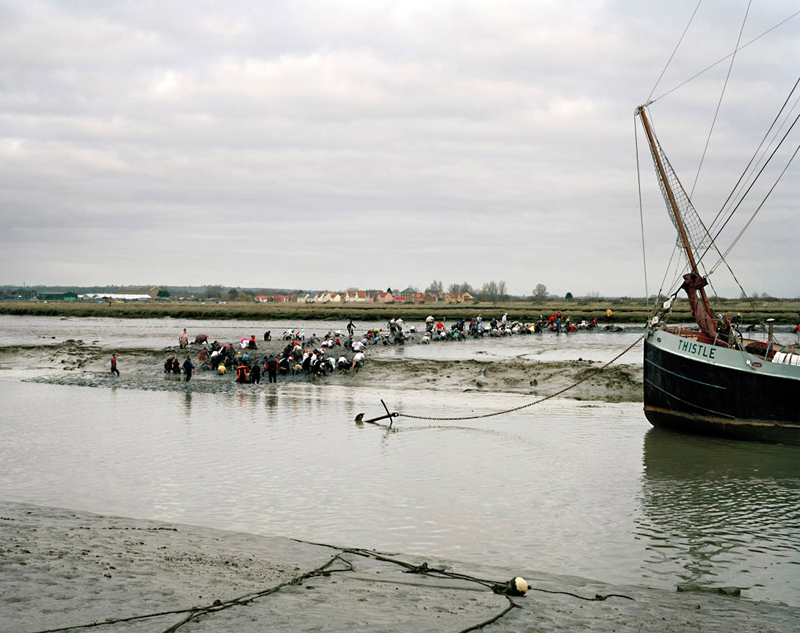
Mad Maldon Mud Race, River Blackwater, Maldon, Essex, 30th December 2007
There are strands of social documentary and also anthropology running through We English. I wanted to address the layering of social activities and of history, and the different ways in which landscape is used and how it changes over time. For example, in the foreground of this photograph taken overlooking the Blackwater Estuary in Maldon, you have a barge anchored on the Blackwater River, a reminder of Maldon’s centuries-old importance as a trading and shipping hub. In the middle distance, we see a couple of hundred people in fancy dress taking part in the Mad Maldon Mud Race. The first mud run in Maldon was in 1973, after a convoluted pub dare where one man challenged another to run across the mud flats. More people joined when the landlord promised a free pint to anyone who could cross the estuary and back. It has since metamorphosed into an annual race raising money for charity. Finally, on the horizon we see a new housing development in Heybridge called ‘The Lakes’. Built by Redrow, it is advertised as ‘an exclusive collection of homes which offer you the chance to escape the city. Nestled between sky, saltmarsh and water, this fantastic location enjoys views of the Blackwater Estuary, meaning that you couldn’t be any closer to nature if you tried.’
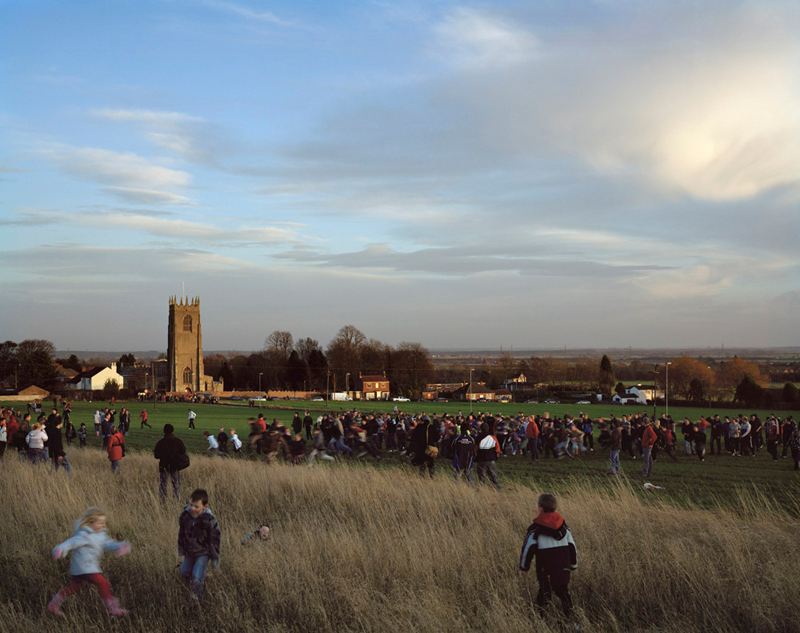
The Haxey Hood, Haxey, North Lincolnshire, 5th January 2008
We English is resolutely not a catalogue of quirky pastimes undertaken by eccentrics. In fact, I discovered that most unusual English events had long been taken over by the marketeers and were obtrusively sponsored, organised and formalised. This photograph, though, I like – partly because the 700-year-old tradition it depicts seems both contemporary and timeless. Every year, villagers in Westwoodside and Haxey compete for possession of ‘the Hood’. The custom began after a certain Lady de Mowbray was out riding her horse one day, and a sudden gust of wind blew her hat off. The local farm labourers chased after it, and Lady de Mowbray was so pleased to get her hat back that she named the person who returned it to her ‘The Lord of the Hood’. The event takes place on the Twelfth Night of Christmas, in a field in Haxey, Lincolnshire, and it’s believed to be England’s oldest traditional tussle. Here, the figures are unmistakeably 21st century, but the landscape is Constable-esque, with the church spire, flat horizon and rolling skies.
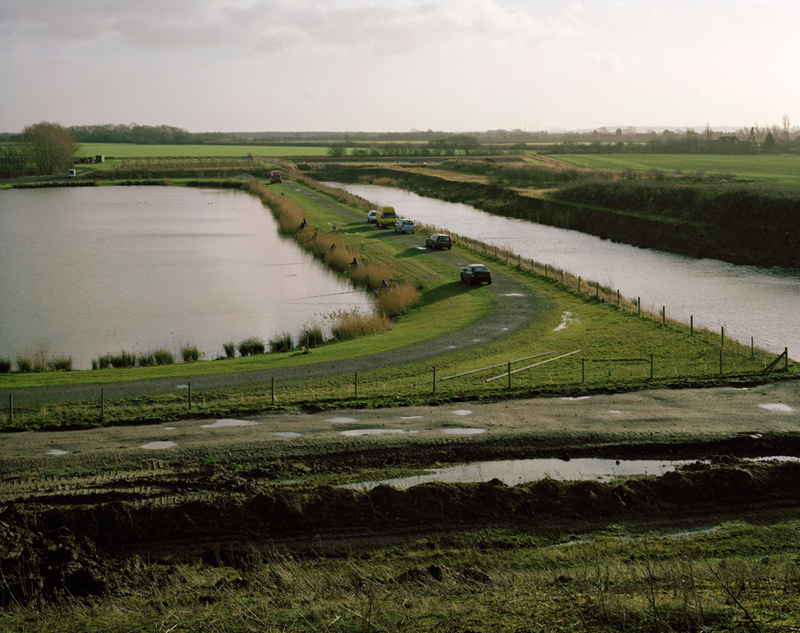 Bank End Fishery, Finningley, South Yorkshire, 5th January 2008
Bank End Fishery, Finningley, South Yorkshire, 5th January 2008
I wanted to produce a body of work that was beautiful, where England was rendered in an unashamedly lyrical way, even if the landscape depicted was somewhat banal. These man-made lakes in Finningley, South Yorkshire, are used for carp fishing. In many ways it is an unremarkable scene, but I imagined that to these fishermen it was a place of refuge, relaxation and even contemplation. Each occupies his own private space, hidden from his neighbour’s view by the rushes and reeds. They seek solitude despite being in a shared space. Their positioning, and even that of their cars, makes its own pattern and shape on the landscape. The effect is regimented and neat, suggesting a ritualised aspect to fishing, and illustrating the paradox of how our wish to ‘commune with nature’ and ‘be at one’ with it is set against the seemingly unstoppable desire to colonise and demarcate the area around us.
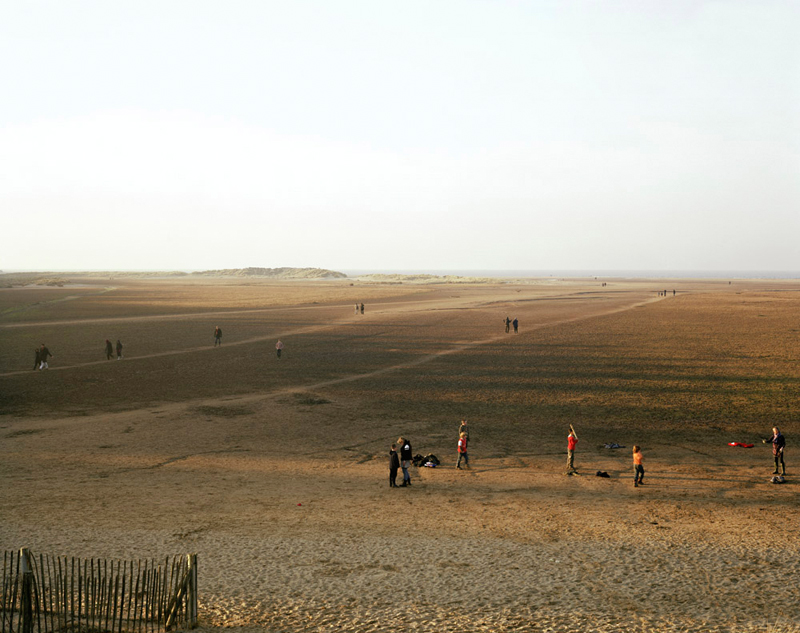 Holkham National Nature Reserve, Norfolk, 18th February 2008
Holkham National Nature Reserve, Norfolk, 18th February 2008
My formal training as a cultural geographer has certainly influenced my work as a photographer. The question of how photographs are important to the construction of senses of place has informed my approach to both Motherland and We English. In the latter, I became interested in exploring the idea that landscapes need to be decoded. This photograph of Holkham National Nature Reserve on the North Norfolk coastline is an example. Here I present a landscape swathed in soft dusky sunlight, bringing together a game of rounders, with a mother chastising her child for unfair play, and a trail of people meandering down to the sea. Holkham has long been a place of pilgrimage for holiday-makers and was recently voted ‘Best Beach 2009’ by readers of Coast Magazine.
As with so much of the English countryside, the visual appearance of this stretch of coast is part wilderness and part constructed landscape. As a result of its proximity to Sandringham, Holkham has often been linked to the Royal Family. It was particularly popular with the Queen Mother, whose own entourage, using the beach in the 1930s, were rumoured to have been responsible for establishing this stretch of sand as a gay beach. Before this, in the 1880s, class collisions in Norfolk were most clearly found in areas where people spent their leisure time. With the development of rail links from London, the Norfolk coastline had begun to attract more socially diverse groups, which meant that the middle classes – who were used to distant and uncomplicated relations with the lower classes – found their holiday-making changed into something much less relaxed. And more recently, in the early 1990s, the press were alerted to a campaign by English Nature, who manage the Holkham estate, to attempt to ‘clean up’ a nudist beach. The local warden declared he would seek a citizen’s arrest on anyone he found cavorting naked in the dunes and woods. In all these ways, it becomes evident that an apparently harmonious, even idyllic, landscape, is rarely simply that; rather, it can be a place of conflict, with different groups of people contesting its ongoing usage, preservation and value.
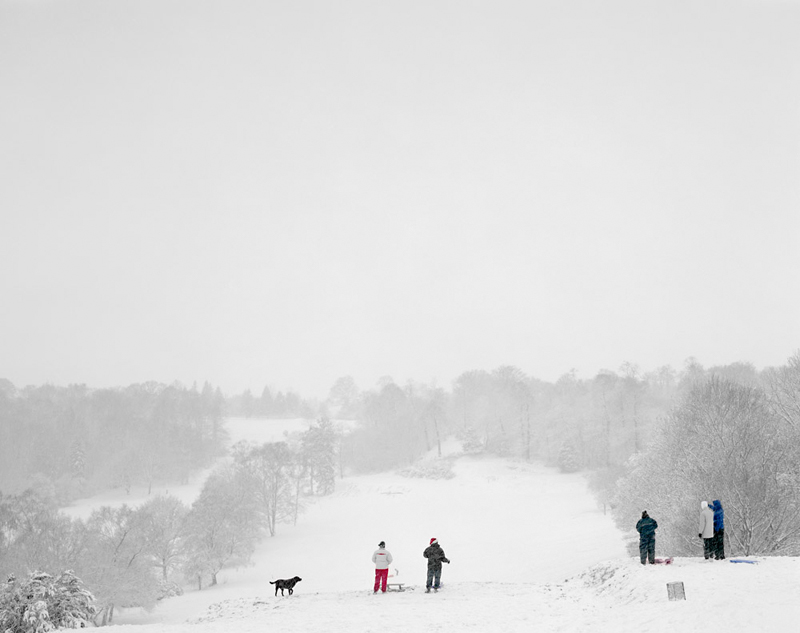 Tandridge Golf Course, Oxted, Surrey, 2nd April 2008
Tandridge Golf Course, Oxted, Surrey, 2nd April 2008
Although I had made several solo trips since starting this work in August 2007, the main leg of my English journey began on May Day 2008, when I was joined by Sarah, my wife, and our daughter, Jemima. Our journey lasted five months – part pilgrimage, part ‘grand tour’, and part survival course (given that we lived and worked in a confined space with a very energetic toddler during one of the wettest English summers on record!).
During the journey, I occasionally sought out places that I believe helped shape my own feelings of Englishness. This scene on the 17th hole of Tandridge Golf Club is near my parents’ home in Oxted and is a place where I used to toboggan as a child. Seeing the families playing there, and now accompanied by a young family of my own, it became apparent that childhood experiences of holidays and leisure are a complex influence, sometimes inspiring love and loathing in equal measure, but often making an indelible imprint on our consciousness of who we are and where we come from. Since I went tobogganing as a child, I would think to do the same with my children. Our history and its associations are vital to our relationship with the landscapes around us. I hope that this photograph captures this esoteric sense of the traditions that inspire belonging, without being sentimental and despite the simplicity of the activities.
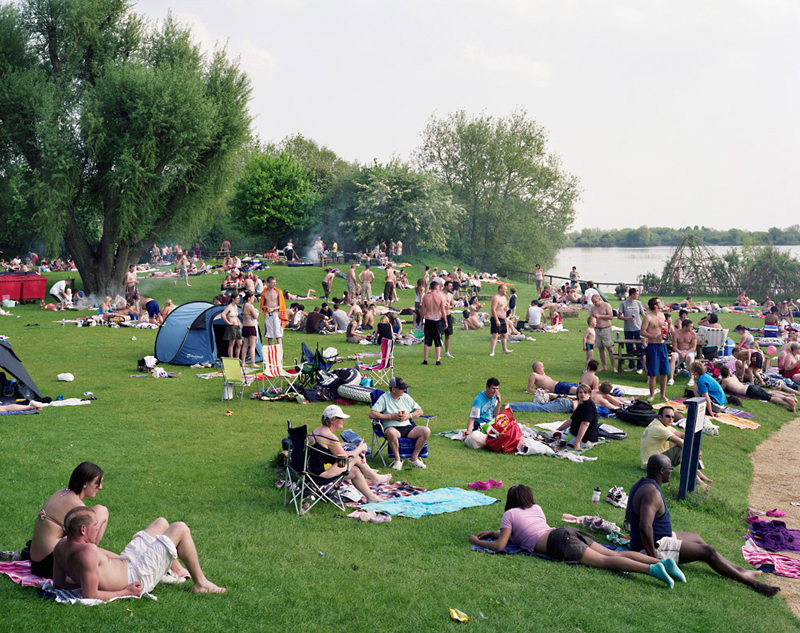 Keynes Country Park Beach, Shornecote, Gloucestershire, 11th May 2008
Keynes Country Park Beach, Shornecote, Gloucestershire, 11th May 2008
In a number of the photographs, scenes of modern-day leisure take place on what were once industrial sites. For instance, the flooding of gravel excavation pits a few years ago created the Cotswold Water Park, which now boasts the largest inland beach in England – Keynes Country Park Beach. Much of the gravel, which had been extracted for over 60 years, was used for building projects in the region.
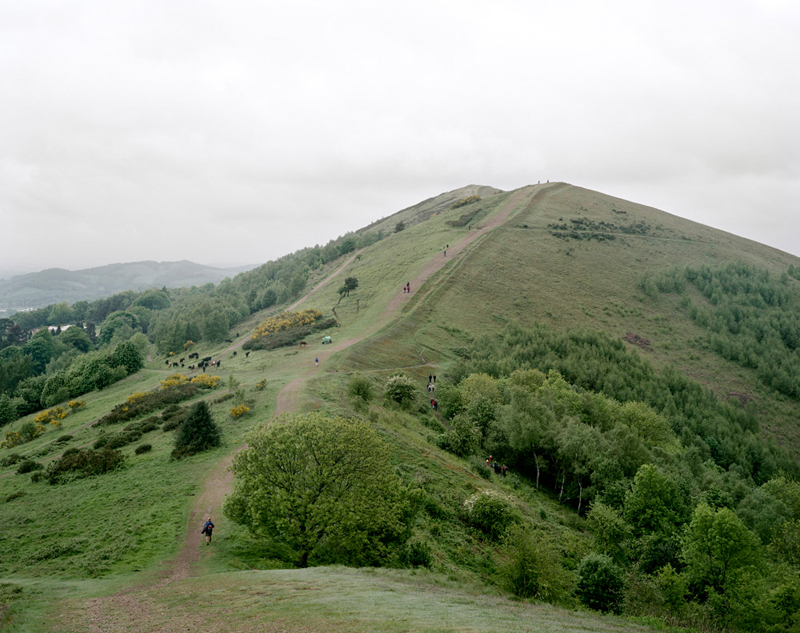 Malvern Hills, Worcestershire, 17th May 2008
Malvern Hills, Worcestershire, 17th May 2008
In most places I visited, I bought a local newspaper to find out about local events and gain some insight into the area. I also found community and village notice boards a valuable resource. This is how I came to photograph the Malvern Hills Sponsored Walk in aid of the St Richard’s Hospice Foundation.
I was conscious that We English shouldn’t solely be about my perception of my homeland. I wanted to get an English audience to talk about what England means to them, but also to invite me to come and photograph an event or leisure pursuit. I set up a website where people could post their ideas, and I received a few hundred suggestions from the general public (they are available to read on the website, www.we-english.co.uk). It struck me as a suitably democratic way of working, positioning me as it did alongside my fellow countrymen – a citizen, not just an onlooker – and attempting to involve people, to a certain degree, in their own representation. The ideas that were posted provide an interesting snapshot of England in 2008 in their own right. They illustrate what’s important to people and explore people’s own ideas on the notion of Englishness. One interesting theme that emerged was the importance of local communities and the strength of attachment that so many people feel to their local area. (A research study by the Economic and Social Research Council, Britain in 2009, showed that the community that really matters to people is geographically local.)
Along with my blog from the project, the website has become a kind of living archive, a diary, tracing its own trail of ideas, debate, questions and insights.
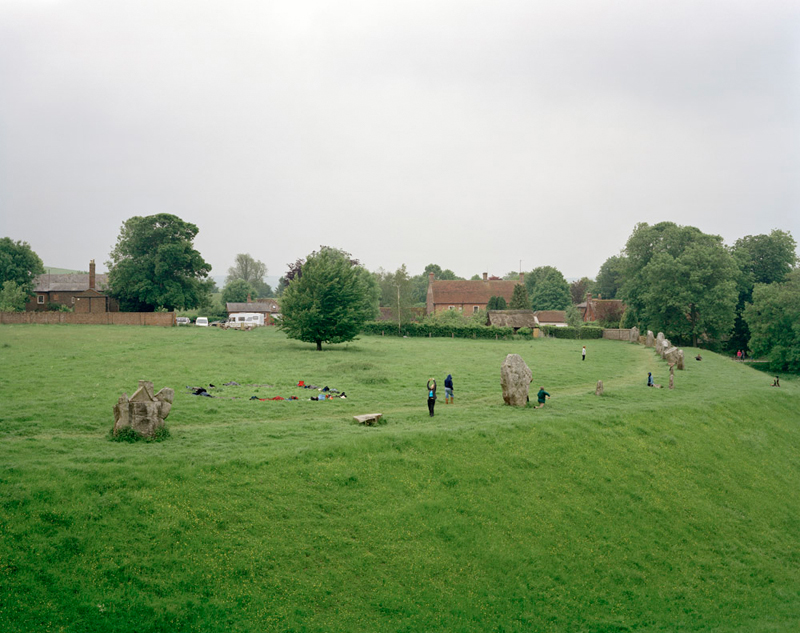 Amerta Movement Workshop, Avebury Henge, Wiltshire, 2nd June 2008
Amerta Movement Workshop, Avebury Henge, Wiltshire, 2nd June 2008
This is the scene that greeted me en route to Stonehenge: about a dozen men and women performing what looked like a form of Tai Chi on and around the rocks that make up the Avebury Stone Circle, one of Europe’s largest prehistoric stone circles. Others lay in the grass with their arms and legs in the air. The group were in fact performing a series of exercises known as ‘Amerta’ moves, part of a ‘Human Nature Ritual Art’ workshop led by Suprapto Suryodarmo, the Indonesian creator of the Amerta Movement.
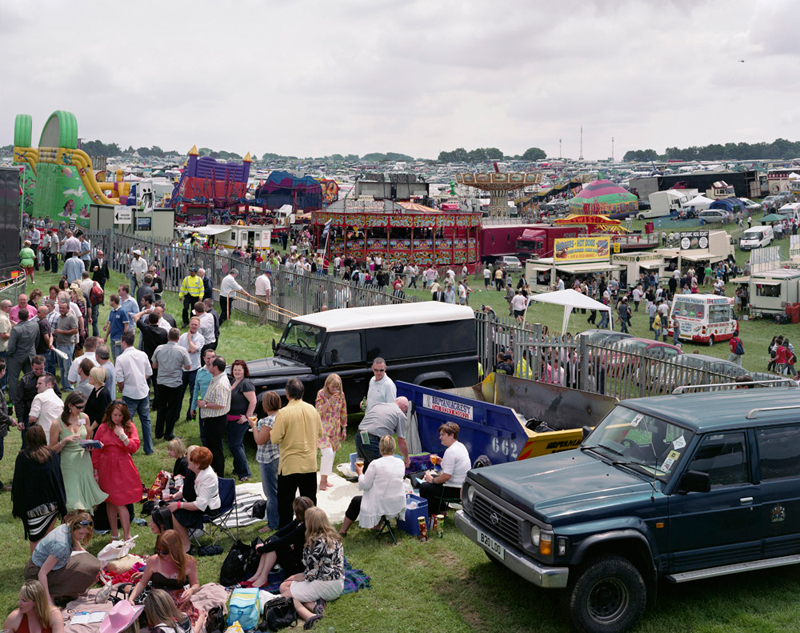 Derby Day, Epsom Downs Racecourse, Surrey, 7th June 2008
Derby Day, Epsom Downs Racecourse, Surrey, 7th June 2008
I thought of William Powell Frith’s painting The Derby Day (1856–58) when confronted by the crowds in the area known as The Hill at the Epsom Derby. The Derby is considered one of the most prestigious flat thoroughbred horse races in the world, and the first recorded race took place in 1661. For spectators, the Derby has long been known for its unique party atmosphere and for the full range of social classes on view, particularly on The Hill, where entry to the centre of the course is free. This photograph is my own contemporary re-creation of Frith’s scene.
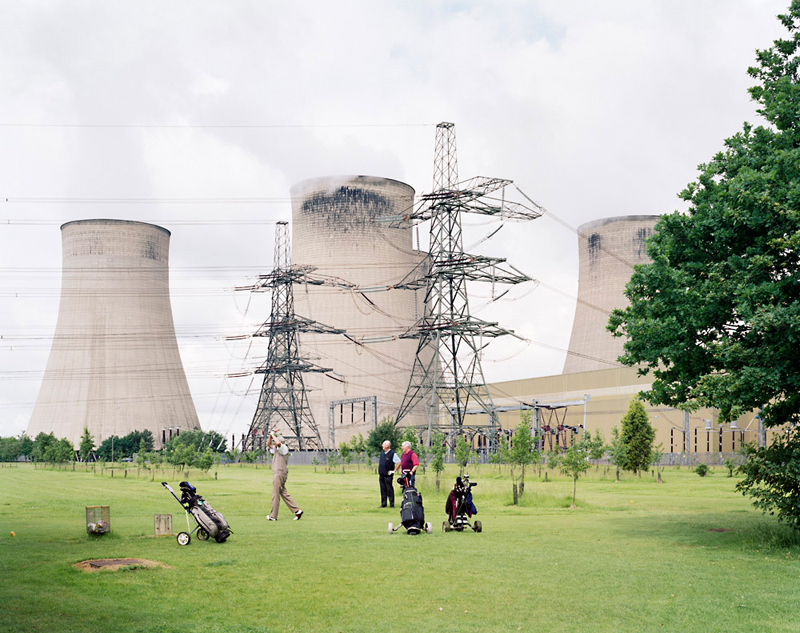 Ratcliffe-on-Soar Power Station, Nottinghamshire, 16th June 2008
Ratcliffe-on-Soar Power Station, Nottinghamshire, 16th June 2008
Ron Whitby, Derek Allen and Tom Burns play a round of golf in the grounds of the Ratcliffe-on-Soar coal-fired power station. The three men started work at the power station in 1966, during its construction, and were employed there until their retirement a few years ago. Despite no longer working at the plant, they still return to play on the employee golf course several times a week.
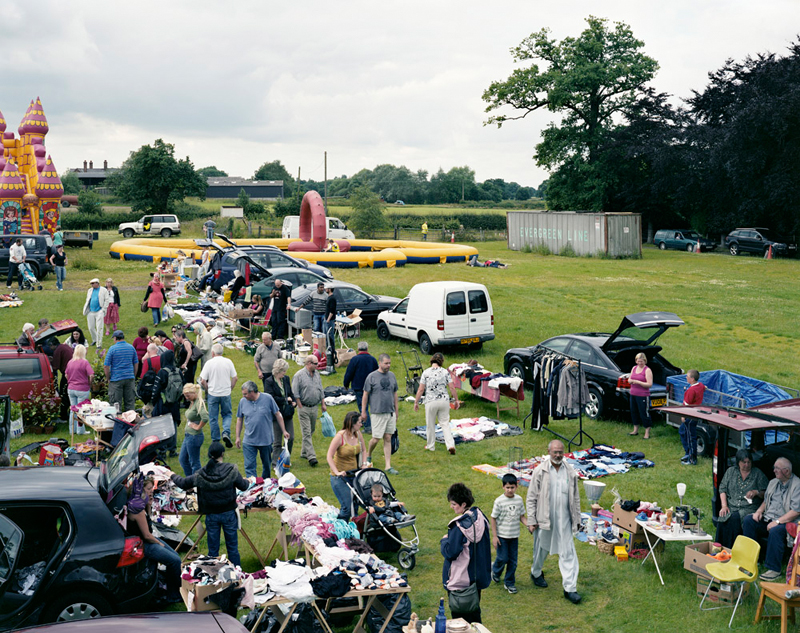 Chelford Car Boot, Moat Hall Farm, Marthall, Cheshire, 13th July 2008
Chelford Car Boot, Moat Hall Farm, Marthall, Cheshire, 13th July 2008
The Chelford Car Boot sale, held every Sunday in a field outside the village of Marthall, is purportedly the second largest in England. It was started by Richard Scott twenty years ago to supplement his income as a farmer, and now attracts thousands of visitors and sellers from across Cheshire.
Photographing a car boot sale was one of the many suggestions posted on the We English website. They included the Castlethorpe Duck Race, Stokenchurch Village Fete & Companion Dog Show, the end of Ramadan celebrations held on the ‘Curry Mile’ in Manchester, the Kite Festival in Washington (sponsored by Nissan), a rave party held on traveller sites in the West Country, village horticultural society shows, the Croydon Summer Festival, well dressing in Derbyshire, Hallaton Bottle Kicking (the origins of the game of rugby as we know it) and lawn mower racing in Billingshurst. Other ideas posted were very personal: ‘Nolton Bay is a lovely cove and really reminds me of my childhood’; ‘Take the road from Leyburn over the top of the Dales and moors for some of the best views in the whole of England’; ‘Walking my dogs through Box Hill on a bright, sunny summer’s morning, followed by a drink at any one of the pubs on the way back home’; ‘Go to Frinton-on-Sea in Essex, the home of my late grandparents. I have really fond memories of a seaside town that was a little odd.’
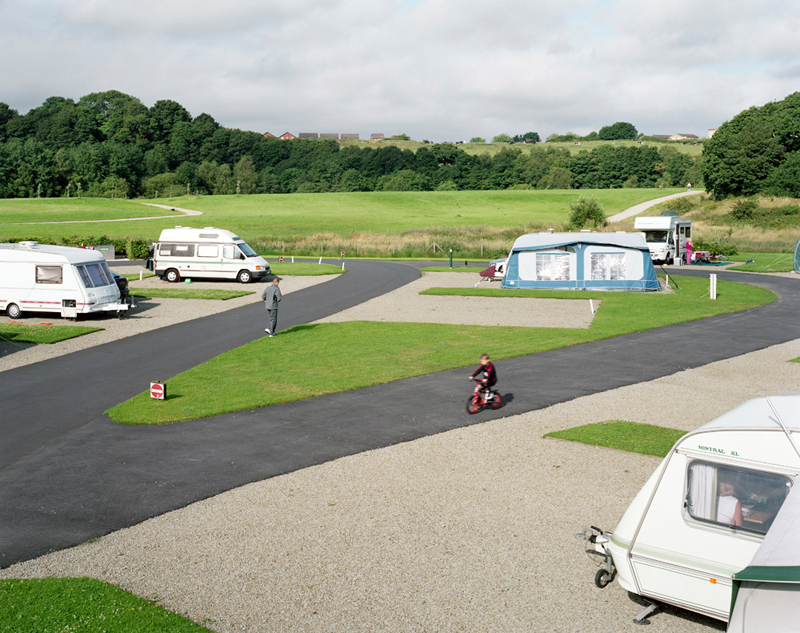
Burrs Country Park Caravan Club, Bury, Greater Manchester, 22nd July 2008
I’ve long been fascinated by the tradition of the road trip in photography. Two of my early influences, the photographers Stephen Shore and Joel Sternfeld, have both employed extended journeys as an avenue for exploring America’s cultural landscape. Similarly, many writers and artists have also made extensive journeys to produce work, from H.V. Morton’s In Search of England (1927) and J.B. Priestley’s English Journey (1934) to Daniel Defoe’s A Tour Through the Whole Island of Great Britain (1724–26) and Patrick Keiller’s film Robinson in Space (1997). In his diaries, J.M.W. Turner talks about extended summer trips around England, where he’d take time to visit his patrons and undertake new commissions. He worked in areas that attracted well-to-do summer tourists and their families, sketching scenes they might like to remember and admire again in watercolours.
However, this image from the Caravan Club site in Bury reminds me of the fact that lots of families holiday locally, travelling only a few miles from their homes in search of ‘leisure’.
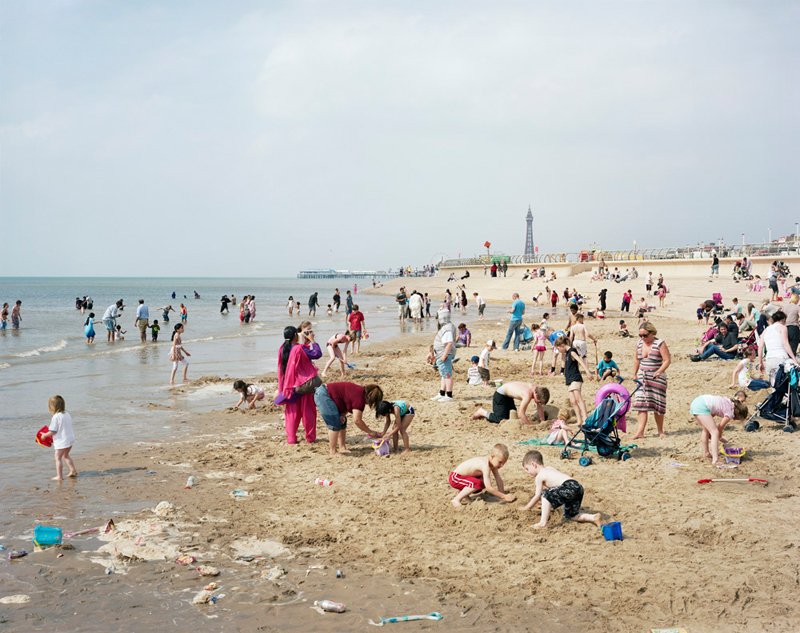
Blackpool Beach, Lancashire, 25th July 2008
The process of setting up the 5×4 camera was quite laborious and often very public, but this turned out to be a help in capturing each scene as it unfolded before me, without any intervention on my part. I had anticipated that there might be problems in situations where there were lots of people close to the camera – like this scene on Blackpool beach – but by the time I’d finished setting up, any curious onlookers had lost interest and turned away.
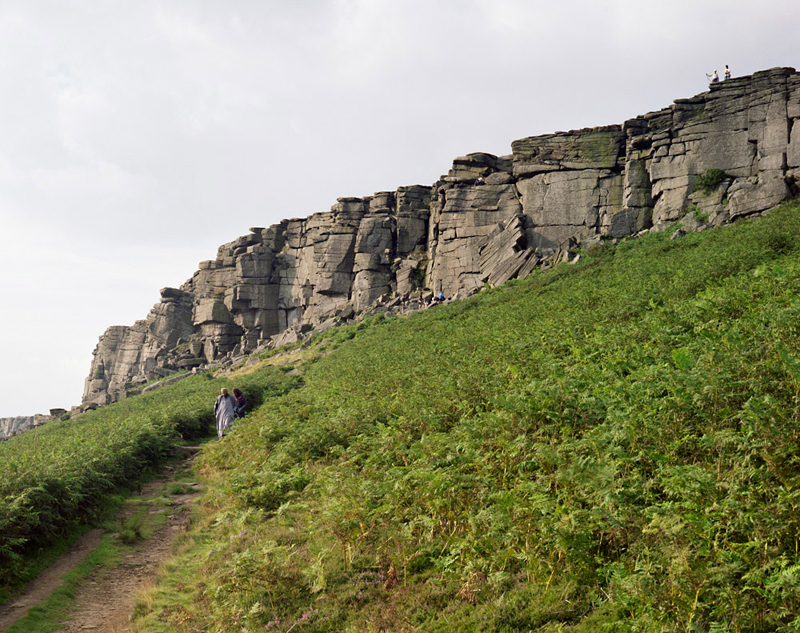 Stanage Edge, Hathersage, Derbyshire, 3rd August 2008
Stanage Edge, Hathersage, Derbyshire, 3rd August 2008
This photograph was taken at Stanage Edge in the Peak District, a popular destination for rock climbers. In the mid-ground a Muslim couple wearing distinctive grey robes follow a footpath down the hillside. We tend to think of these kinds of views of rural England being inhabited by the white middle classes, and I like that this photograph challenges the stereotype. Talking to the couple depicted, I learned that they were from Leicester on a week’s walking holiday, staying at a B&B in the nearby village of Hathersage. They spoke of feeling completely at ease in the area and described how they often spend their holidays exploring the English countryside.
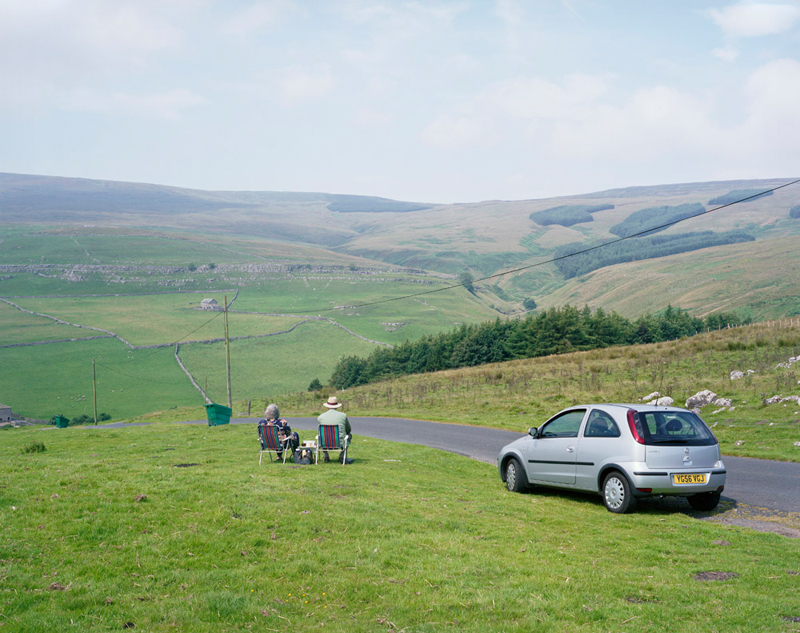 Fountains Fell, Yorkshire Dales, 3rd August 2008
Fountains Fell, Yorkshire Dales, 3rd August 2008
Les and Doreen Barnett, pictured here next to the road from Malham to Arncliffe, have been coming to admire this view for almost 50 years. They claim that, during this time, all that has changed is a new tractor on the farm and the unwelcome arrival of several roadside salt bins. Traffic is heavier at the weekends, so they only come on a weekday morning, normally a Monday. The route is a beautiful one, cutting through the picturesque limestone landscape of the South Pennines in the Yorkshire Dales. Yet I was reminded of a quote from W.G. Hoskins’ book The Making of the English Landscape (1955): ‘Not much of England, even in its more withdrawn, inhuman places, has escaped being altered by man in some subtle way or other, however untouched we fancy it is at first sight.’
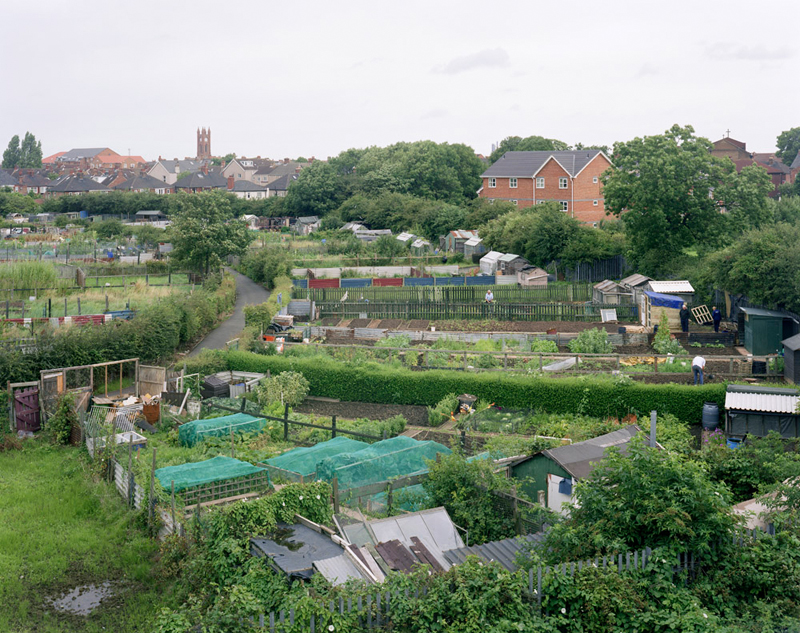 Whitehouse Allotments, Middlesbrough, North Yorkshire, 11th August 2008
Whitehouse Allotments, Middlesbrough, North Yorkshire, 11th August 2008
Even in the centre of towns and cities, I found myself drawn to the green spaces, where there’s a definite sense of ‘going out into nature’; a sense that being in nature, however meagre, is a retreat from normal life: an opportunity for repair or rejuvenation, as well as an aesthetic experience. I suppose photographs like this one reflect that idea of a pastoral idyll; they stop short of being outright romantic interpretations of a scene and – like the figures that populate them – they are conscious that this idyll is a construct: an allusion to an imagined way of life.
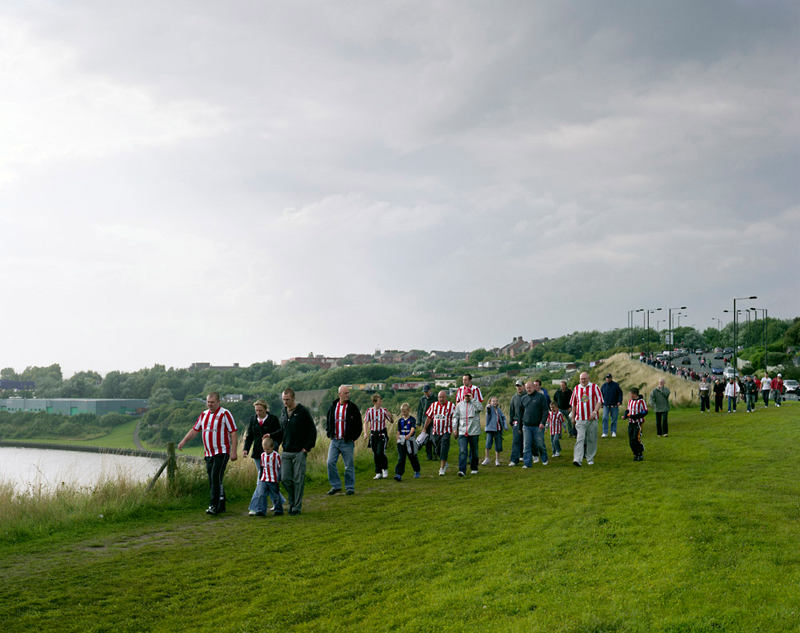 Sunderland vs. Liverpool, Sunderland, Tyne and Wear, 16th August 2008
Sunderland vs. Liverpool, Sunderland, Tyne and Wear, 16th August 2008
Here, local Sunderland AFC fans make their way down to the Stadium of Light, ready for the opening match of the season against Liverpool FC. The stadium opened in 1997, and was built on the former site of Wearmouth Colliery, a coal mine on the north bank of the River Wear. The colliery was the deepest mine in the world when it opened in the 1830s. As the fans wend their way down to the stadium, the atmosphere is almost one of pilgrimage. The name ‘Stadium of Light’ is a reference to a miner’s lamp. I imagine some of the older male Sunderland fans had worked at the colliery; indeed this walk to the football ground probably traced the exact path their fathers and grandfathers had taken to work every day.
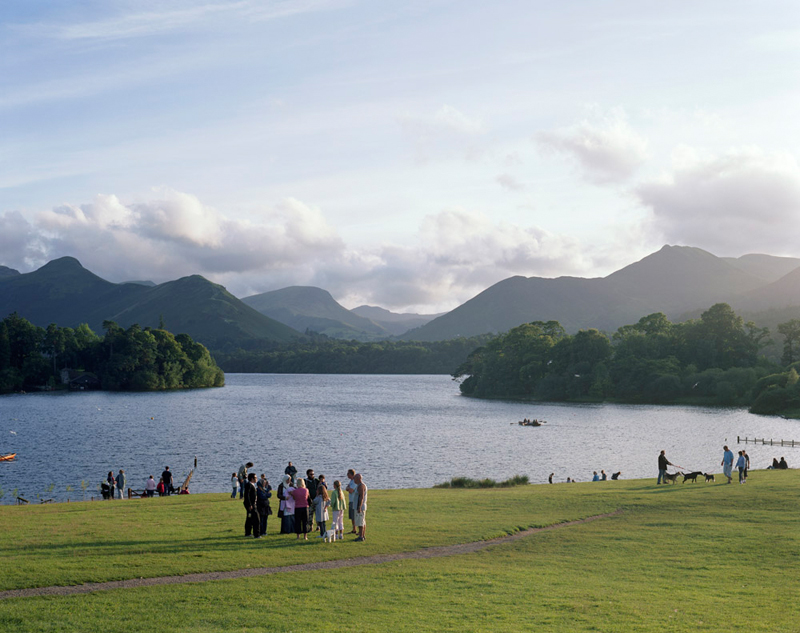 Derwent Water, Keswick, Cumbria, 27th August 2008
Derwent Water, Keswick, Cumbria, 27th August 2008
The low point of making this series was dealing with the unseasonably wet weather that blighted the summer of 2008. It was particularly bad in Cumbria, where the region saw almost an entire month’s worth of rainfall during the first twelve days of August.
This photograph, on the shores of Derwent Water in Keswick, was taken at dusk after a heavy storm. Of course, the unpredictability of the English climate has long been seen as one of the keys to our national character. It has also informed much of the character of English art: think of the moisture which steams out of Turner’s canvases or Constable’s attention to atmosphere, which makes his paintings so clear and fresh.
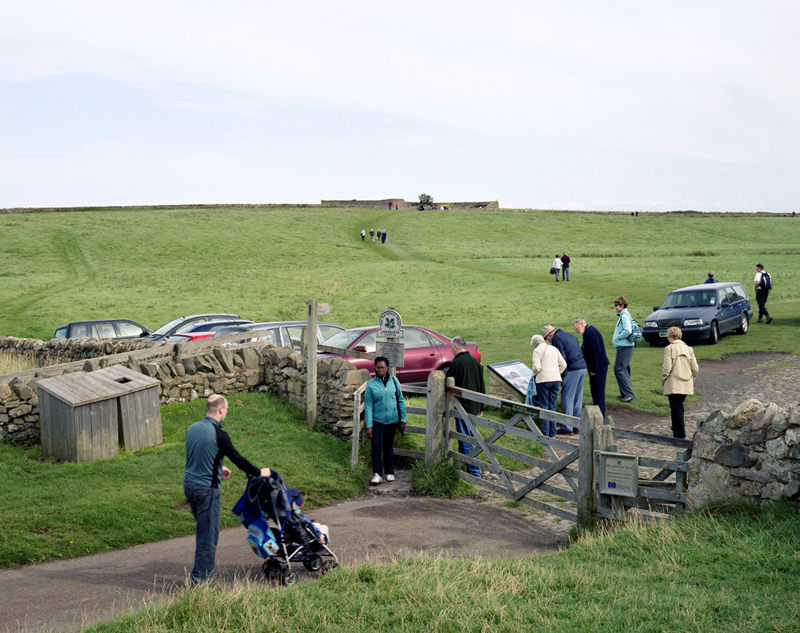 Holy Island of Lindisfarne, Northumberland, 2nd September 2008
Holy Island of Lindisfarne, Northumberland, 2nd September 2008
Lots of the leisure activities I photographed occurred at boundary points: the edge of cities, next to lakes and reservoirs, alongside footpaths and mountain ridges. This photograph shows the entrance gate to Lindisfarne Castle on Holy Island, a site owned by the National Trust. I liked this sense of literal and metaphorical boundaries, of ‘edges’ that are created or unconsciously preserved. During the editing process, I noticed how many of the landscapes I photographed are shot through with rivers, trees and hedges that create physical divisions, just as the people themselves create their own personalised environments. These divisions impose a new structure upon the landscape and have a beauty of their own.
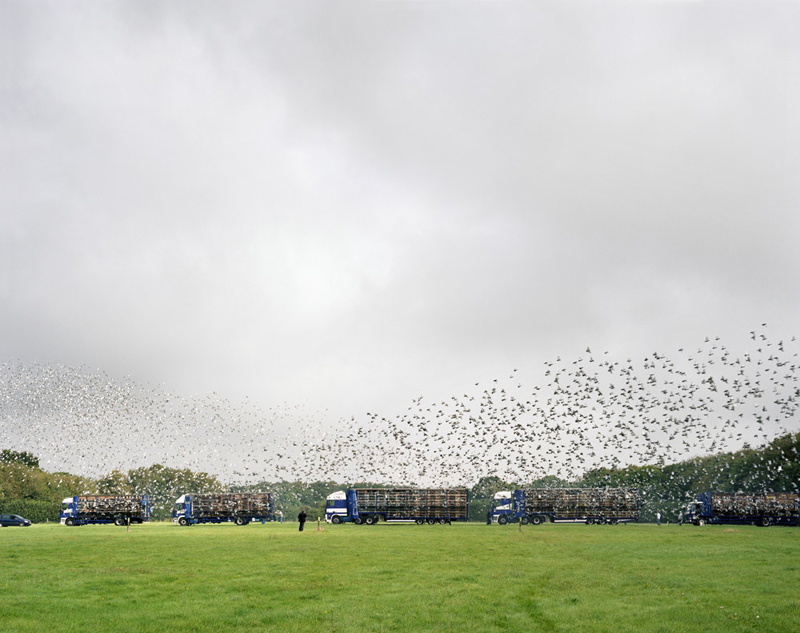 Maidstone Young Bird National Pigeon Race, Maidstone, Kent, 13th September 2008
Maidstone Young Bird National Pigeon Race, Maidstone, Kent, 13th September 2008
The book ends with this photograph of the liberation of twenty thousand racing pigeons in the Maidstone Young Bird Nationals from Kent Showground in Maidstone. The pigeons belonged to racers from the Up North Combine, and were flying back to their owners’ lofts dotted along the Northumberland coastline.
SIMON ROBERTS
Brighton, May 2009
Posted in POST PRODUCTION, REVIEWS & PRESS | 10 Comments »
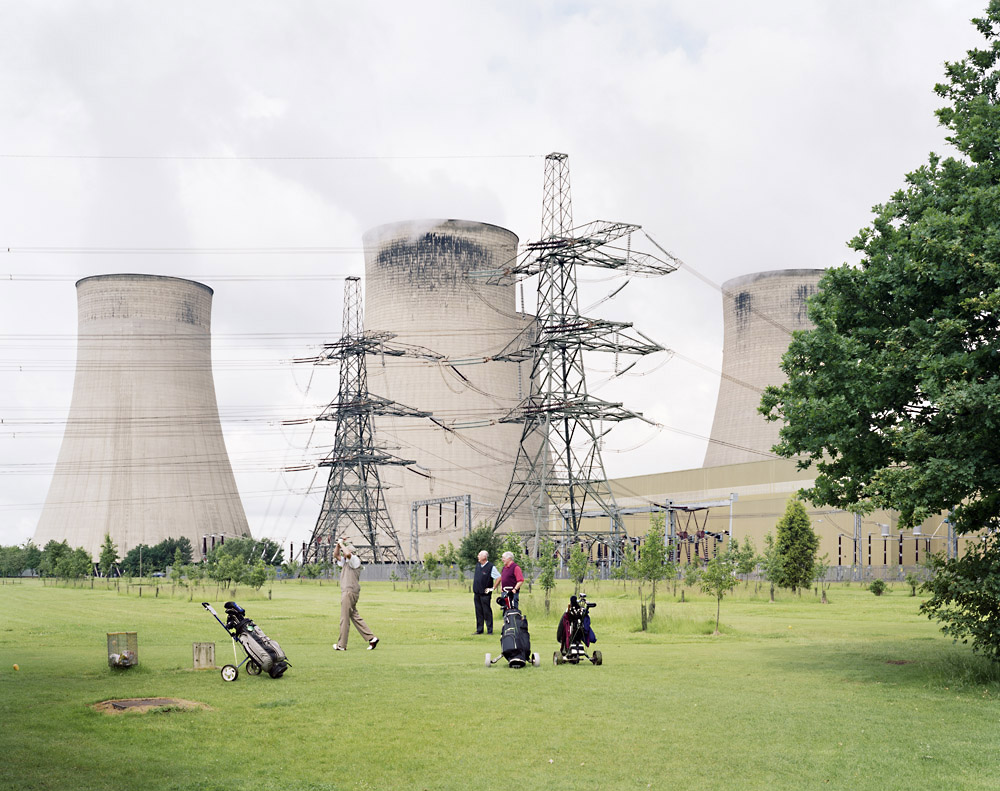


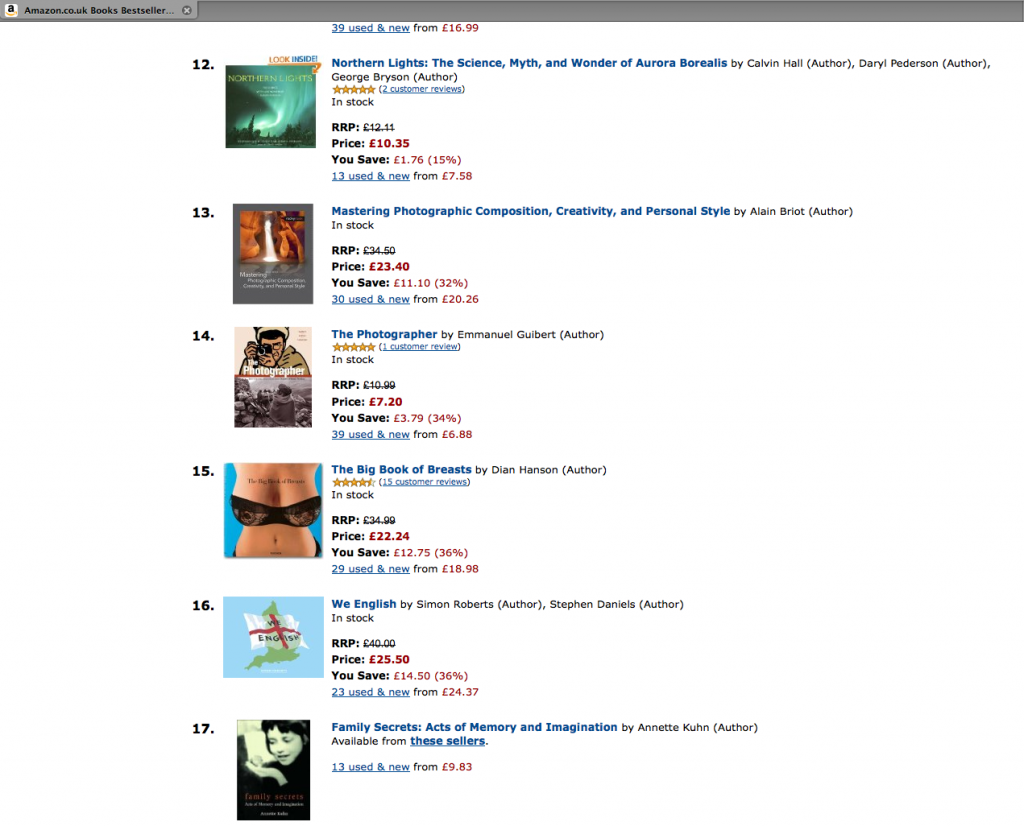

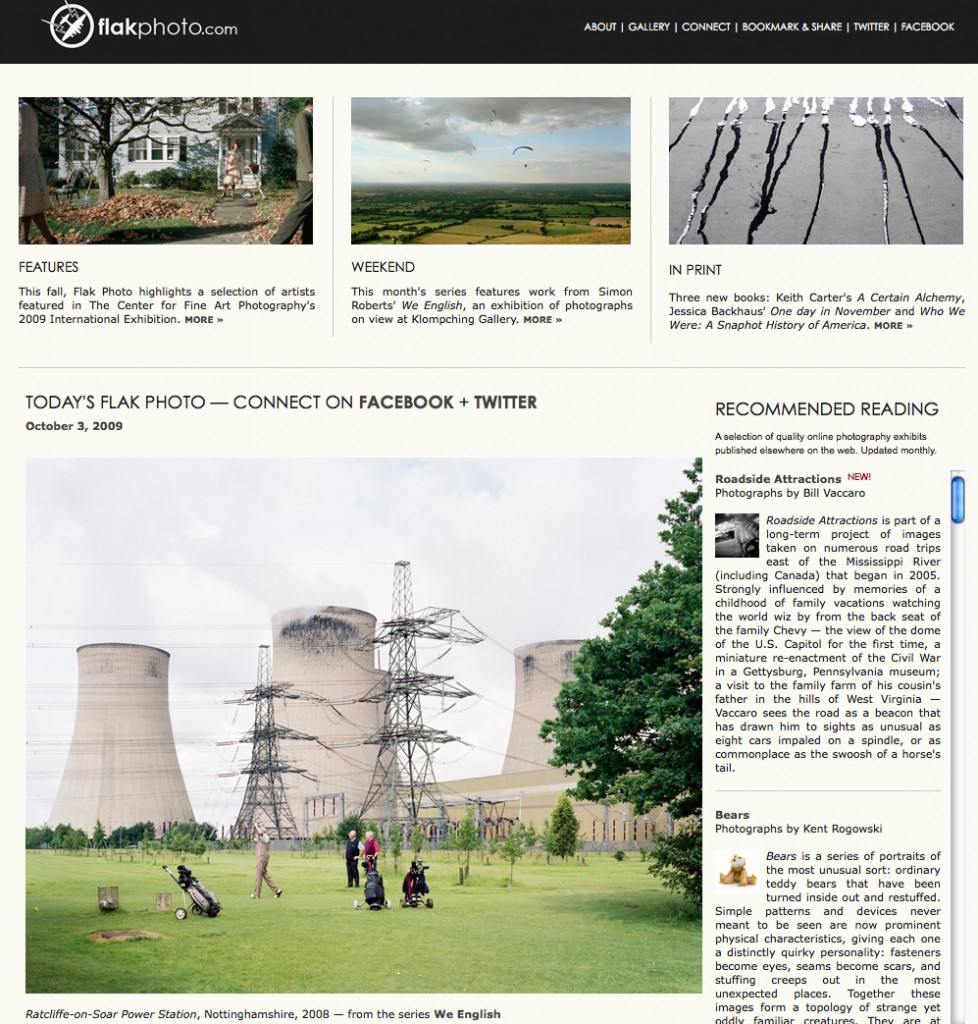
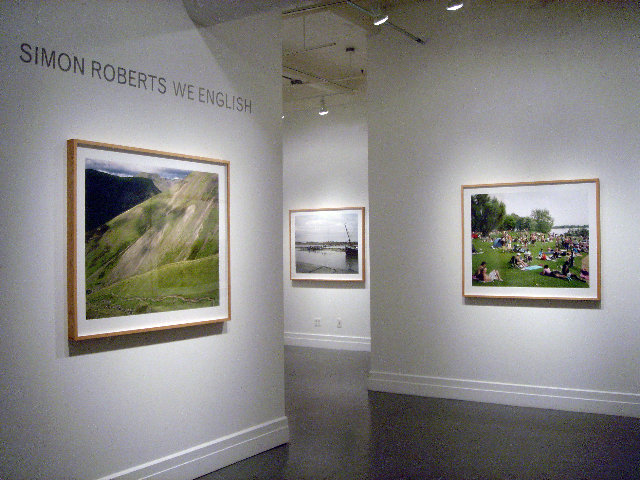
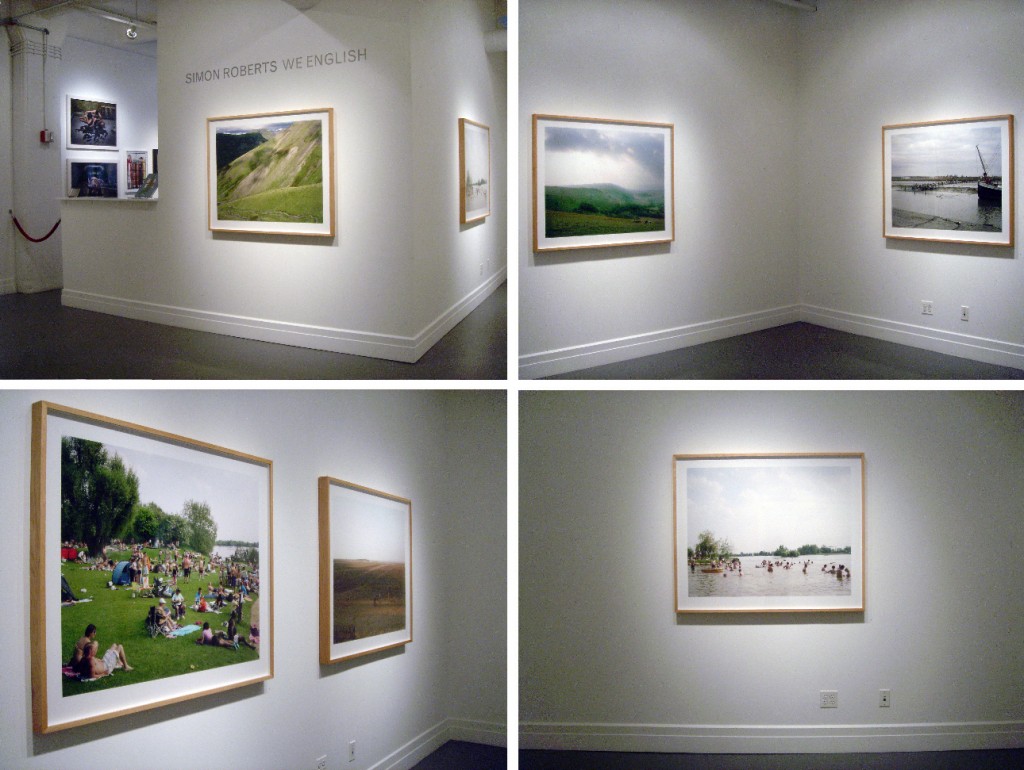
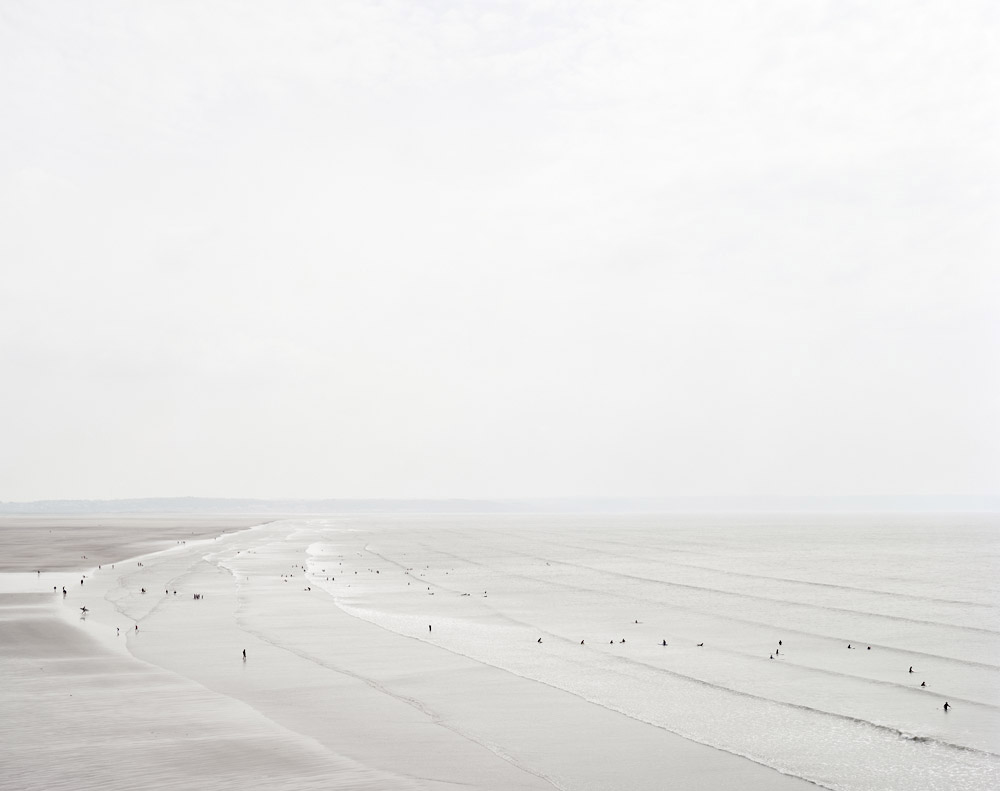
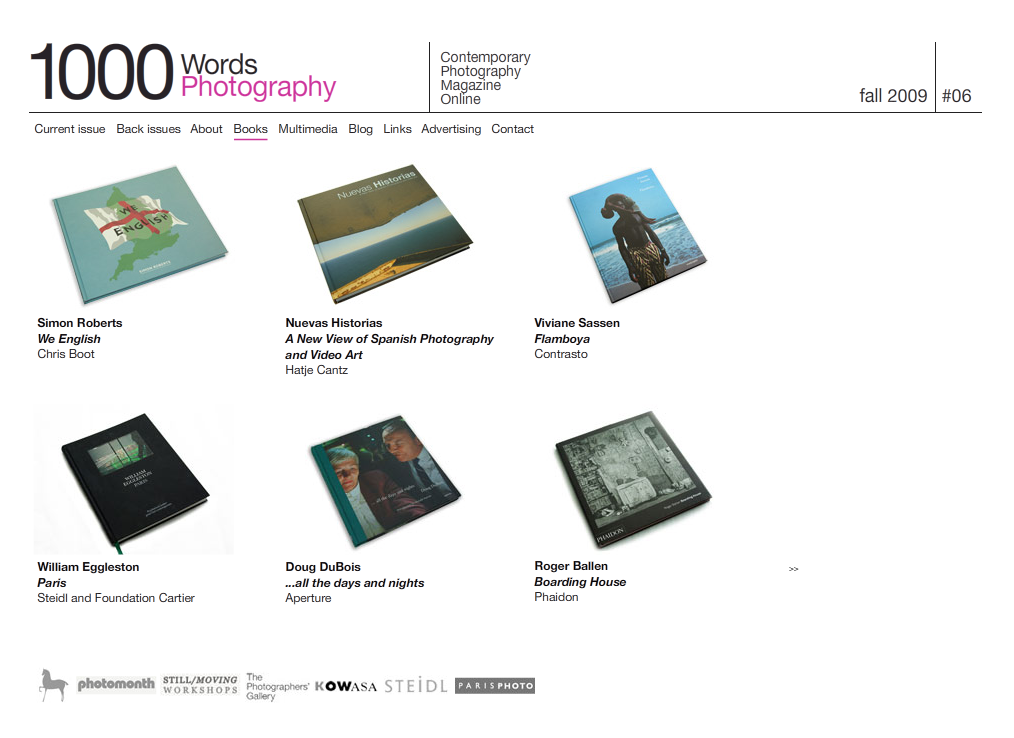
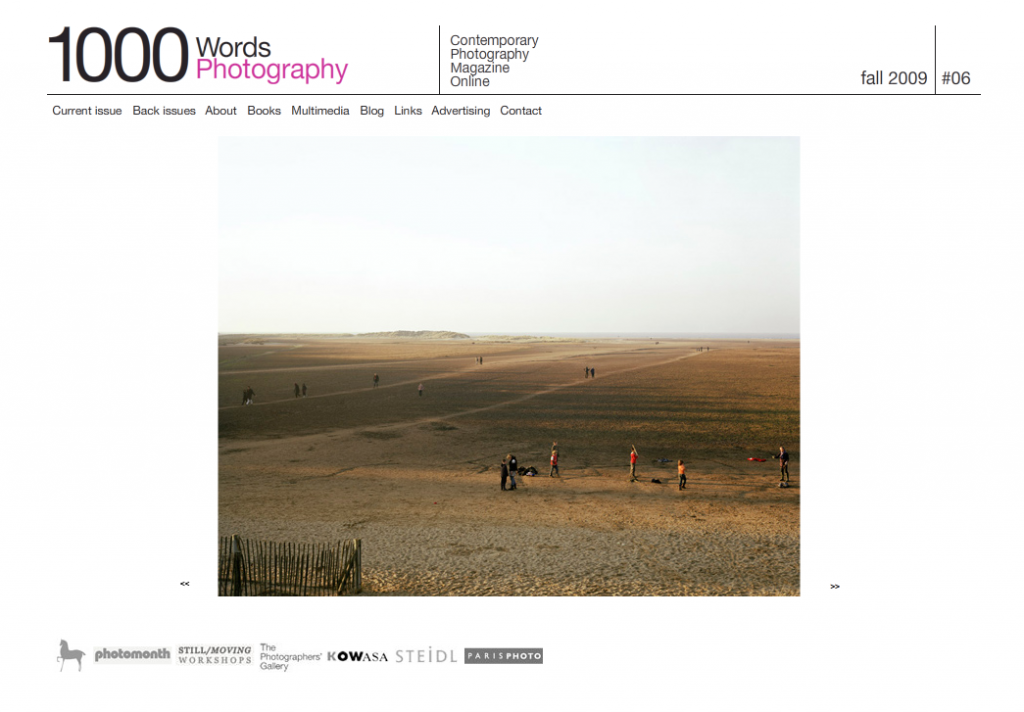
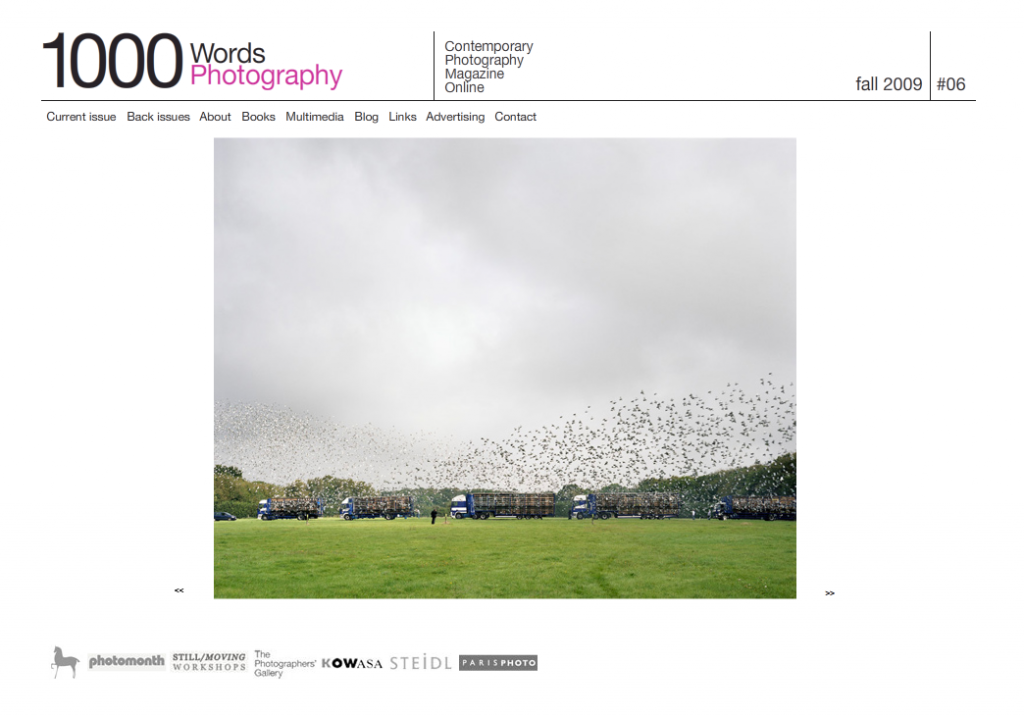
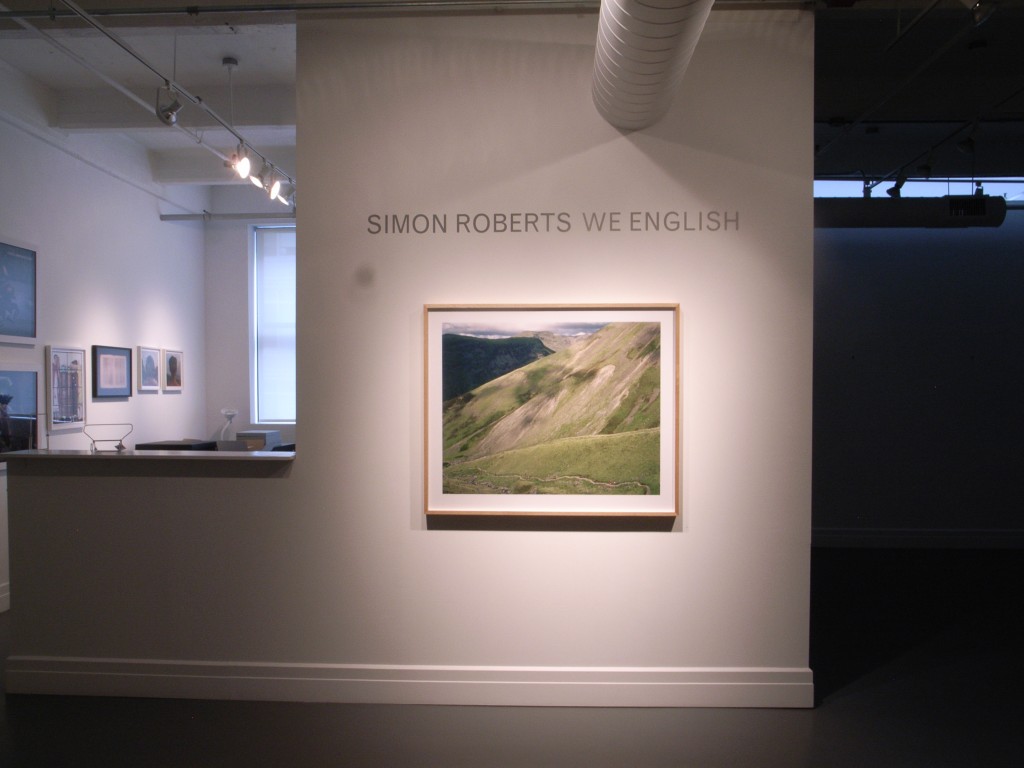
 Skegness Beach, Lincolnshire, 12th August 2007
Skegness Beach, Lincolnshire, 12th August 2007
 Heberdens Farm, Finchdean, Hampshire, 20th December 2007
Heberdens Farm, Finchdean, Hampshire, 20th December 2007

 Bank End Fishery, Finningley, South Yorkshire, 5th January 2008
Bank End Fishery, Finningley, South Yorkshire, 5th January 2008 Holkham National Nature Reserve, Norfolk, 18th February 2008
Holkham National Nature Reserve, Norfolk, 18th February 2008 Tandridge Golf Course, Oxted, Surrey, 2nd April 2008
Tandridge Golf Course, Oxted, Surrey, 2nd April 2008 Keynes Country Park Beach, Shornecote, Gloucestershire, 11th May 2008
Keynes Country Park Beach, Shornecote, Gloucestershire, 11th May 2008 Malvern Hills, Worcestershire, 17th May 2008
Malvern Hills, Worcestershire, 17th May 2008 Amerta Movement Workshop, Avebury Henge, Wiltshire, 2nd June 2008
Amerta Movement Workshop, Avebury Henge, Wiltshire, 2nd June 2008 Derby Day, Epsom Downs Racecourse, Surrey, 7th June 2008
Derby Day, Epsom Downs Racecourse, Surrey, 7th June 2008 Ratcliffe-on-Soar Power Station, Nottinghamshire, 16th June 2008
Ratcliffe-on-Soar Power Station, Nottinghamshire, 16th June 2008 Chelford Car Boot, Moat Hall Farm, Marthall, Cheshire, 13th July 2008
Chelford Car Boot, Moat Hall Farm, Marthall, Cheshire, 13th July 2008

 Stanage Edge, Hathersage, Derbyshire, 3rd August 2008
Stanage Edge, Hathersage, Derbyshire, 3rd August 2008 Fountains Fell, Yorkshire Dales, 3rd August 2008
Fountains Fell, Yorkshire Dales, 3rd August 2008 Whitehouse Allotments, Middlesbrough, North Yorkshire, 11th August 2008
Whitehouse Allotments, Middlesbrough, North Yorkshire, 11th August 2008 Sunderland vs. Liverpool, Sunderland, Tyne and Wear, 16th August 2008
Sunderland vs. Liverpool, Sunderland, Tyne and Wear, 16th August 2008 Derwent Water, Keswick, Cumbria, 27th August 2008
Derwent Water, Keswick, Cumbria, 27th August 2008 Holy Island of Lindisfarne, Northumberland, 2nd September 2008
Holy Island of Lindisfarne, Northumberland, 2nd September 2008 Maidstone Young Bird National Pigeon Race, Maidstone, Kent, 13th September 2008
Maidstone Young Bird National Pigeon Race, Maidstone, Kent, 13th September 2008